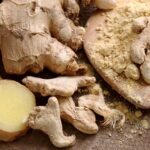A team of researchers at NABI has developed three varieties of coluored wheat; purple, blue, and black. These varieties are enriched with antioxidants called anthocyanins. This is the first time in India, that coloured wheat varieties that are adapted to the local climate and soil conditions have been developed.
Now there is a way of making your chapattis, cakes, and bread more nutritious, and perhaps a wee bit colourful. Scientists from the National Agri-food Biotechnology Institute (NABI), Mohali, Punjab, have developed new varieties of coloured wheat that are enriched with antioxidants and minerals.
Dr. Monika Gargand and her team of researchers at NABI have developed three varieties of coloured wheat; purple, blue and black. These varieties are enriched with antioxidants called anthocyanins. Anthocyanins are the naturally occurring chemicals that give blueberries their colour. Fruits like Jamun, pomegranates, plums, and vegetables like brinjal and bell peppers are rich sources of anthocyanins too. Regular inclusion of anthocyanins in our diets can remove harmful free radicals from the body and help in preventing many lifestyle disorders like obesity, heart diseases, diabetes, inflammation, etc.
Foods enriched with anthocyanins like black carrots, plums, and purple wheat have been previously introduced commercially in markets abroad. Coloured wheat is commercially sold in New Zealand, Canada and many countries in Europe. But these do not thrive well in the Indian climate. However, this is the first in India, that coloured wheat varieties that are adapted to the local climate and soil conditions have been developed.
Major challenge in growing coluored wheat
The major challenge in growing coluored wheat varieties is its low yield. Scientists, therefore, crossed the donor lines of coloured wheat (blue, purple, black) procured from the USA and Japan with high yielding white wheat varieties grown in North-West India. After many permutations and combinations, they were successful in developing purple, blue, and black wheat for India.
Though the average yield of coloured wheat is comparatively low, its price is definitely lower than rice. Moreover, with people getting health conscious day by day, they wish to eat nutritional diet. Coloured wheat can provide all such benefits.
The anthocyanins content is the highest in black wheat followed by blue and purple. The purple wheat grains have anthocyanins in their pericarp, the outermost layer of the wheat grain. The blue wheat grains have it enclosed within their aleurone layer in the seed. Aleurone layer is the living part of the wheat seed and is a reservoir of nutrients. The black grain has anthocyanins both within its aleurone and pericarp layer.
Anthocyanins present in these coloured wheat varieties
Over 26 different anthocyanins are present in these three coloured wheat varieties. Among the three coloured wheat varieties developed, purple has larger sized grains that are comparable to the size of the white wheat grains that are available in the markets. The minerals and antioxidants within them are also more readily absorbed by the body.
However, on long-term storage (more than a year), purple wheat lost their colour and nutrient value to some extent, probably because the antioxidants are found in the outer layer of the grain which is more prone to destruction by external factors. On the other hand, the black and the blue wheat varieties were found to have richer micronutrient content as nutrients are enclosed within the innermost layers of the grain. This makes them more suitable for long-term storage than the purple variety.
Tests conducted on coloured wheat
Tests conducted on laboratory mice fed on coloured wheat reveal good antioxidant and anti-inflammatory activities, reduced obesity, reduction in blood glucose, and cholesterol levels. Coloured wheat contains a significant proportion of carbohydrates and dietary fibers but at the same time have lower levels of sugars as compared to fruits rich in anthocyanins, making it an ideal diet to control diabetes and obesity. Obese mice fed with a high-calorie diet, rich in fat were supplemented with white wheat and the coloured wheat varieties.
The ones fed with coloured wheat gained less weight. These mice also had lower blood glucose and cholesterol levels. Another experiment showed that stress-related biochemicals were lower in black wheat fed mouse, indicating their potential role in decreasing daily stress. Another clinical trial carried out on humans by Chineses researchers has been published in the international journal and it has found the anti-diabetic potential of black wheat.
These three varieties of coloured wheat are more nutritious and beneficial to health as they are not just enriched with anthocyanins but are naturally biofortified with minerals such as iron and zinc. Zinc is an essential micronutrient and its deficiency is very common in the Indian subcontinent. The larger part of the Indian population also suffers from iron deficiency. Consumption of coloured wheat on a day-to-day basis will help bridge this gap to some extent, the scientists hope.
These lines also have a higher amount of dietary fibers and proteins. Consumption of adequate amount of proteins is very important for normal growth, development, and maintenance of the body. A very high number of Indians suffer from protein malnutrition. Dietary fibers are required for fecal bulking and good intestine health. Good bacteria in our intestine use dietary fibers and maintain the good health of our intestine.
It took 10 years to develop these coloured wheat varieties
It has taken Dr. Garg and her team nearly 10 years to develop the three coloured wheat varieties. The field trials were conducted in Punjab, Haryana, UP, MP, Gujrat during the winter and in Kelong, Lahaul Spiti in Himachal Pradesh during the summer season. The yield of the three coloured wheat varieties was approximately around 17 quintals per acre as compared to 20 quintals per acre for white wheat varieties. “It would earn more remuneration to farmers due to its health benefits. The yield will improve with the further generation of plants,” she informs.
A patent filed
Dr. Garg has already protected her invention by filing a patent. She is also exploring the many ways in which the coloured wheat can be integrated into our daily diets. She is signing MOUs with different companies in India for manufacturing, distribution, and sale of coloured wheat products like atta, bread, biscuits, cakes, roasted snacks, lavach, etc. She is interested in products with varying shelf life. The products with lower shelf life like bread can be consumed in large quantities.
But products with a longer shelf like biscuits can be easily stored and transported to different states of India and more people can get benefit from it. Atta would be best for manufacturing chapatti and roti at consumer convenience. It would be a comparatively healthier product than white wheat meda or atta products for children and adults. However, “consumption of coloured wheat at higher scales is necessary to test its long-term health benefits in people,” says Dr. Garg.
















